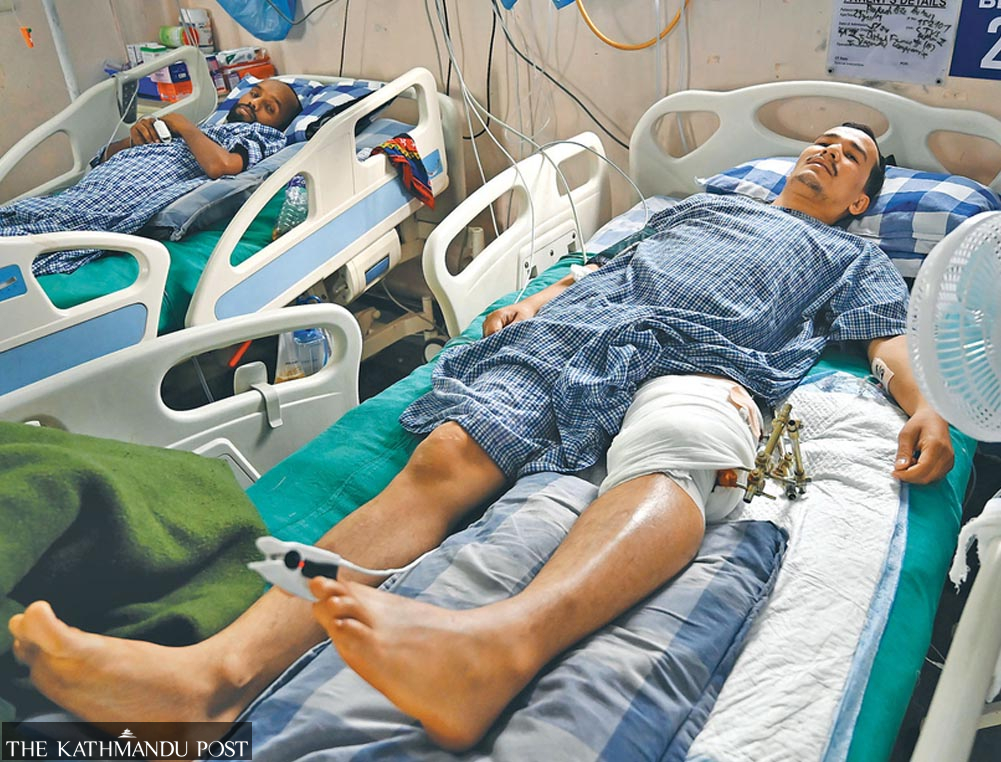National
The white shoe that became a symbol of Nepal’s Gen Z rebellion
Bought with hard-earned wages from serving in the Russian army, the blood-soaked shoe of 28-year-old Prakash Bohara now stands as an enduring icon of the Gen Z movement.
Samarpan Shree, Bibek Pokhrel & Daya Dudraj
Two weeks have passed since the Gen Z protests upturned Nepal’s political landscape. Yet, on social media, images of the movement’s defining moments and reminders continue to circulate. Among them, one symbol has seized the public’s imagination more than any other: a blood-soaked white shoe.
Whose shoe was it? Whose foot, pierced by a bullet, left it behind?
It belonged to 28-year-old Prakash Bohara of Dailekh, who now lies in a hospital bed at the National Trauma Centre, Kathmandu, recovering from surgery.
Prakash had joined the protests on the morning of September 8 with friends, determined to make his generation’s voice heard. He marched past tear gas, right up to the walls of the Parliament building in New Baneshwar.

“I was pulling at the iron bars [of the building] when a bullet struck my left leg,” he recalled softly, his words breaking the silence of the ICU. His brother-in-law captured the moment on video—the white shoe visible, the chaos that followed unmistakable.
Prakash remembers little beyond the sudden rush of blood, the stumble to the ground, and the frantic voices in the ambulance. Somewhere in that confusion, someone removed his shoe. The left one, drenched in red, had already fallen away. Days later, as he lay recovering, he learned from family that his shoe had gone viral; an enduring symbol of resistance was his own.
But the story of the shoe stretches far beyond the protests. It is tied to Prakash’s own restless search for survival. After completing his Health Assistant degree in 2016, he struggled to find steady work. His family’s small shop and farm could not sustain the family, and debts piled up from rebuilding their earthquake-shattered home.
Then came the war in Ukraine. Seeing few other options, Prakash enlisted in the Russian army—becoming one of dozens of Nepali youths who gambled with their lives in a foreign war. Many never return. By chance, Prakash did.
From his soldier’s pay, he bought a motorbike and, on the way home, a pair of discounted Samba-brand white trainers in Nepalgunj for Rs1,500. He sent a photo of the shoes to his wife, Radika, over WhatsApp on May 8. She loved them, urging him to buy them. Those shoes, rarely worn but dearly cherished, would one day get him enlisted in history.
On learning of his injury, his wife, a 16-month-old son, and his aging mother were devastated. “He had promised to be home for Dashain,” his mother said tearfully at the hospital. “Instead, we got this news.” Radika, clutching her 16-month-old child, confessed she had only learned of her husband’s involvement in the protest from neighbours who saw his name among the injured.
Doctors say Prakash’s recovery will take time. The bullet tore through his thigh, damaging veins and nerves. More surgeries await. Yet, despite the pain, he speaks of hope rather than loss. “If the blood I spilled can bring about good governance and end corruption, then it will not have been wasted,” he said.
For Prakash, the white blood-stained shoe is no longer just an item of clothing. It is the emblem of a struggle shared by countless young Nepalis: a fight for dignity, for jobs, for a country that does not force them to seek survival in foreign wars.
And so, from a dusty shop in Nepalgunj to the viral feeds of a nation, one simple shoe now carries the weight of an entire generation’s dreams.




 10.12°C Kathmandu
10.12°C Kathmandu
















